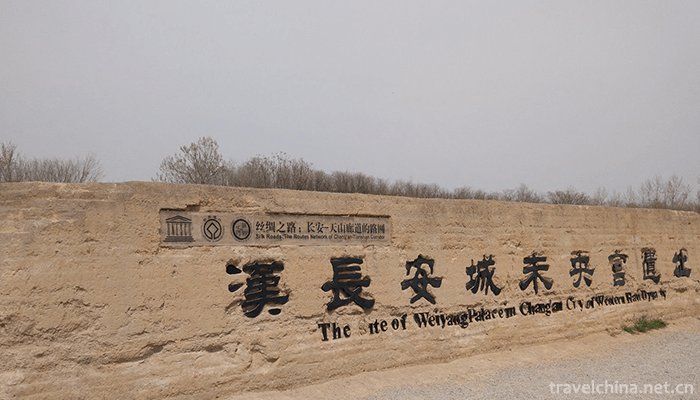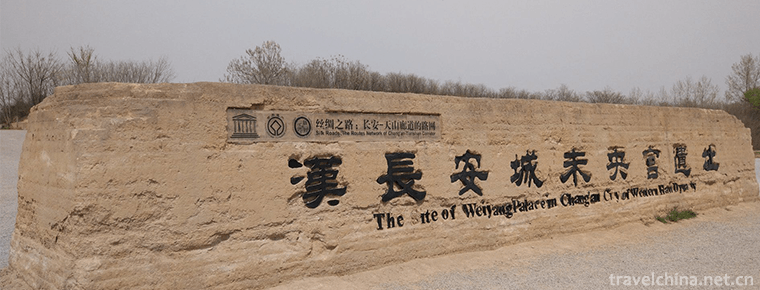Weiyang Palace Site in Changan City Han Dynasty
Weiyang Palace Site in Changan City Han Dynasty
The site of Weiyang Palace in Chang'an City of Han Dynasty, located in the southwestern part of the site of Weiyang District, Xi'an City, Shaanxi Province, was built in the seventh year of Han Gaozu (200 years ago) and destroyed in the war at the end of Tang Dynasty. It survived in 1041. It is the most used and longest-lived Imperial Palace in Chinese history.
Weiyang Palace, also known as the Western Palace, is the main hall of the Western Han Empire, the center of the Western Han Empire's decrees for more than 200 years. After the Western Han Dynasty, it was still the administrative land of many dynasties. Sui and Tang Dynasties were also classified as part of the Forbidden Garden.
On March 4, 1961, the Weiyang Palace Site in Chang'an City of Han Dynasty was declared as the first batch of national key cultural relics protection units by the State Council. On June 22, 2014, at the 38th UNESCO World Heritage Committee meeting in Doha, Qatar, the Weiyang Palace Site in Chang'an City, Han Dynasty, was successfully listed on the World Heritage List as a site of the Silk Road: Road Network of Chang'an-Tianshan Corridor, which was jointly applied for by China, Kazakhstan and Kyrgyzstan.
Historical evolution
Chang'an, the capital of the Western Han Empire, where the Weiyang Palace is located, is the political, economic and cultural center of the whole country, and is also a famous international city. As the "palace" of the Han Empire, the Weiyang Palace is the most important building in Chang'an City of Han Dynasty. It has an important influence on the ancient capital system of China. It has become one of the most famous palaces in ancient China because of its longest use period and far-reaching influence on later generations. In 1956, the Institute of Archaeology of the Chinese Academy of Sciences (the predecessor of the Institute of Archaeology of the Chinese Academy of Social Sciences) formed the Han Chang'an City Task Force and began the archaeological work of Han Chang'an City. From 1961 to 1962, the Task Force conducted a preliminary exploration of the Weiyang Palace. Since the 1980s, the Task Force has carried out all-round archaeological exploration and key excavation of the Weiyang Palace site.
In the spring and autumn of 1980, a preliminary investigation and drilling were carried out on Jiaofang Palace building site (No. 2 building site of Weiyang Palace). A review was conducted in the spring of 1981. The site was excavated on a large scale from October to December 1981 and from February to May 1982. Supplementary excavations were carried out from March to May 1983. Site No. 2 of Weiyang Palace is 180 meters west of Daliuzhai Village, Weiyang Palace Township, Weiyang District, Xi'an City. It is located 330 meters north of the former palace site of Weiyang Palace and 275 meters south of Tianluge site.
From April to June and October to December 1980, the site of Area A and Area B of Qiandian Architectural Site (No. 1 of Weiyang Palace) was excavated.
From December 1985 to January 1986, September 1986 to May 1987, Ding excavated the building site of the Central Government Office (No. 3 building site of the Weiyang Palace). The site is 100 meters east of Lujiakou Village, Weiyang Palace Township, Weiyang District, Xi'an City. It is located 880 meters northwest of the former palace site of Weiyang Palace and 105 meters west of the Western palace wall of Weiyang Palace.
From September 1987 to May 1988, Shaofu (or the government office under its jurisdiction) building site (No. 4 building site of Weiyang Palace) was excavated . The site is located in the southwest of Kejiazhai Village, Weiyang Palace Township, Weiyang District, Xi'an City. It is 400 meters southeast from the former palace site of Weiyang Palace, and 350 meters east of the second building site of Weiyang Palace (the Jiaofang Palace site).
From October 1988 to April 1989, the building site of the Southwest Corner Tower of Miyagi City (No. 5 of the Weiyang Palace) was excavated. Located in the north of Cheliu Village, Sanqiao Town, Weiyang District, Xi'an City.
In addition, during the decade of the 1980s, the layout of the Weiyang Palace was comprehensively explored, and some palace gates, walls and roads were partially excavated.
Tourism information
Address: The site of Weiyang Palace in Chang'an City of Han Dynasty is located in the urban and rural areas of Weiyang District, Xi'an City, about 2 kilometers north of the South Bank of Weihe River. The site is located in seven villages: Daliuzhai, Majiazhai, Xiaoliuzhai, Kejiazhai, Zhoujiahe Bay and Lujiakou.
Tickets: Free.
Traffic: Buses No. 234 and No. 331


-
1.Hakka stuffed tofu
Hakka-brewed tofu, also known as minced meat-brewed tofu and Dongjiang-brewed tofu, is one of Hakka's famous dishes and is said to be related to...
Time 2018-11-02 -
2.Lingnan Impression
Lingnan Impression Park is located in the south of Guangzhou University Town (Xiaoguwei Island). It covers an area of 16.5 hectares. It is a tourist attraction that gathers sightseeing
Time 2019-02-03 -
3.Yangda Kuduktur Beacon Platform Site
Beacon also known as beacon platform, beacon platform, Yandun, pyrotechnic platform. If there were enemies, smoke in the daytime and fire in the evening were the quickest and most effective ways to tr
Time 2019-03-02 -
4.Lantern Opera
Flower lantern opera is a kind of traditional opera widely popular in China. Its prominent feature is that the hands are inseparable from fans and handkerchiefs, singing and dancing
Time 2019-05-04 -
5.Ming style Furniture Making Skills
Ming-style furniture production techniques began in the Five Dynasties, after the Song Dynasty, including Liao and Jin Dynasties. In the Ming Dynasty, it reached a brilliant peak and developed into di
Time 2019-06-05 -
6.Pingnanping Opera
Pingnanping opera is a kind of traditional opera with a history of 400 years. As the predecessor of Fujian opera, the main features of the opera are that Taobai singing uses Fuzhou Mandarin, the front
Time 2019-06-09 -
7.March 3 She Nationality
March 3rd is the traditional festival of She nationality. Every year in this festival, a grand song is held, and ancestors worship Valley God, singing and dancing. It is very lively. In addition, we h
Time 2019-06-14 -
8.Uygur Daolang Maxi Refu
Maigaiti County is located in the southwest of Xinjiang Uygur Autonomous Region. It is a typical Uygur inhabited area. About 89% of the population is Daolang Uygur who can sing and dance well. Among t
Time 2019-06-26 -
9.The Yi Nationality Plays Songs
The dance of the Yi nationality is colorful and varied. It is typical of the simple collective dance "Da Song" (also known as "Ta Song") with the entertainment of the masses. In Mi
Time 2019-07-12 -
10.Zao Bang
Zaobao is one of the traditional local operas in Shandong Province. It is mainly popular in Heze, Yuncheng, Liangshan, Juye, Juye, Juancheng and Dingtao. It developed under the influence of local lang
Time 2019-07-16 -
11.Corn and sparerib soup
Corn and spareribs soup is a tonic soup, the main ingredients are corn and spareribs, the main cooking technology is stew. Corn can reduce the blood cholesterol concentration and prevent it from depos
Time 2020-03-16 -
12.Neijiangs first industry
In 2019, the sown area of grain crops in Neijiang is 309600 ha, an increase of 0.3% over the previous year; the sown area of oil crops is 79900 ha, an increase of 0.4%; and the sown area of vegetables is 78100 ha, an increase of 2.3%. The total grain output
Time 2020-12-16